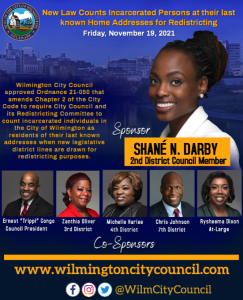New Law Counts Incarcerated Persons at their last known Home Addresses for Redistricting

Wilmington City Council approved a new ordnance that amends Chapter 2 of the City Code to require City Council and its Redistricting Committee to count incarcerated individuals in the City of Wilmington as residents of their last known addresses when new legislative district lines are drawn for redistricting purposes.
Council voted 11-0 (2 absent) to pass the new law during their regular city council meeting on Thursday, November 18, 2021, and is now awaiting Mayor Mike Purzycki’s signature. You can read the complete Ordnance 21-050 to amend Chapter 2 of the City Code here, and you can view the meeting here.
Every ten years, local governments use new census data to redraw their district lines to reflect how local populations have changed. The City of Wilmington started the process of redistricting its eight councilmanic districts on August 25, 2021. Previously, the process counted incarcerated persons as residents of the prison location. When City Council used Census counts to draw legislative districts, they unintentionally enhanced the weight of the population in the first district that contains Plummer Community Corrections Center and the third district that contains the Howard R. Young Correctional Institution, informally known as Gander Hill Prison, at the expense of all other districts in the state. Wilmington has now corrected this problem.
Under the law, sponsored by Council Member Shané Darby of the 2nd District and co-sponsored by Council President Ernest “Trippi” Congo, 3rd District Council Member Zanthia Oliver, 4th District Council Member Michelle Harlee, 7th District Council Member Chris Johnson, and At-Large Council Member Rysheema Dixon, City Council will now be required to count incarcerated individuals in the State of Delaware or federal correctional facilities at their respective last known addresses to every future redistricting, beginning with the redistricting that occurs as a result of the federal decennial census of 2020. The following language has been added to Section 2-32 (“Redistricting after census; committee procedures; implementation.”) of the City Code:
(g) The committee shall prepare, or cause to be prepared, the tabulations of population statistics for the existing city council districts in order to determine the degree of disparity, if any, in population among the existing council districts and the racial and ethnic composition of each council district. The committee shall count incarcerated individuals for redistricting purposes in accordance with section 2-32.1 of this article.
“When I think about redistricting, I think of protecting vulnerable communities, protecting communities of interest, and making sure that even 10 years from now that people are going by procedures and policies that make sense and that are equitable, that are fair, that are not bias, and that doesn’t equal to buddymandering,” said Council Member Darby during her closing comments of the regular city council meeting. “I am really invested in legislation and hoping to draft more legislation of what redistricting will look like in 10 years and making that a better process for Wilmington. Because I believe that everything we do, even down to redistricting and how we draw lines, will have impact on communities for decades, for generations, and I just really think it’s important that while I’m in this seat that I take that power to say hey, I want to protect these communities and be a voice. So, I just want to say thank you again (to my council colleagues) for supporting the legislation.”
###
MEDIA INQUIRES:
Yesenia Taveras
Director of Communications
Wilmington City Council
Office: (302) 576-2585
Email: ytaveras@wilmingtonde.gov
City Council Website: www.wilmingtoncitycouncil.com

